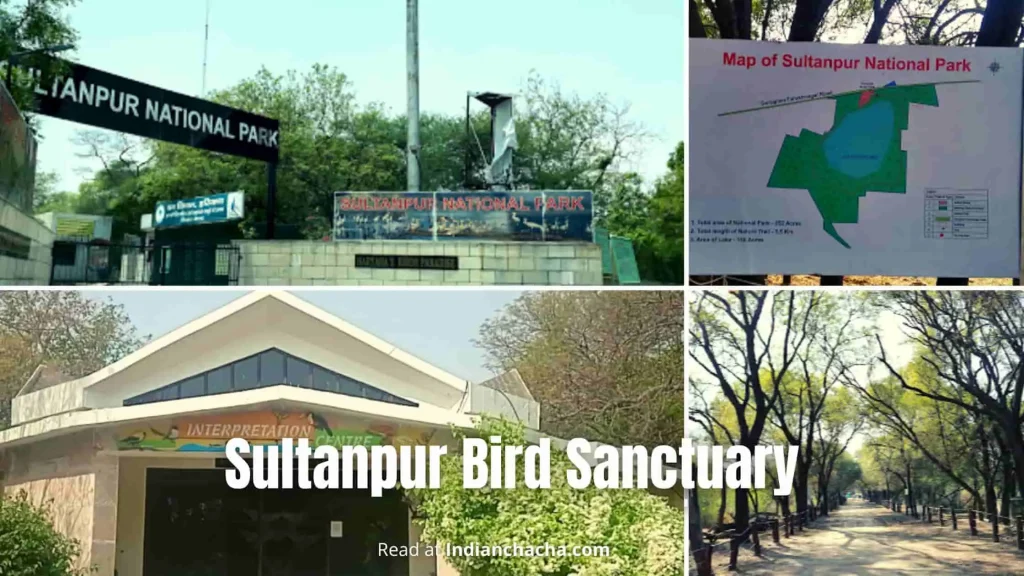Is Sultanpur Bird Sanctuary worth visiting? What is the best time to visit Sultanpur Bird Sanctuary? Why is Sultanpur Bird Sanctuary famous?
I am Somraj Mondal, the Content Developer at indianchacha.com. In this blog post, I will show you complete details of the Sultanpur Bird Sanctuary.
Here, you will learn about,
- About and History of the Sanctuary
- Flora and Fauna
- Accommodation Facility
- Best Time to Visit
- And, much more information
Let’s get started.
Table of Contents
Sultanpur Bird Sanctuary, Gurgaon Overview
Sultanpur Bird Sanctuary is located on the Gurgaon-Farooq Nagar road, in Delhi. This is one of the perfect Weekend Gateways from Delhi to spend time in Nature. In winter, more than 250 species of Birds are found here, this time, many Bird watchers and Bird Lover came here to see the wide range of Native and Migratory Birds.
The government of Haryana declares the Sultanpur Bird Sanctuary a National Park. This Sanctuary is home to a large number of Migratory and Residents birds. Migratory Birds came here from different regions of Europe, Siberia, and Central Asia.
Authority and Forest Department take steps to plan more trees to improve the vegetation of the area and make a destination for birds such as Ficus spp.
History of Sultanpur Bird Sanctuary
Basically, Sultanpur is named after Rajput Chauhan Sultan Singh, who was the great-grandson of Harsh Dev Chauhan. In the 19th century, Sultanpur was a center of salt production The potential of Sultanpur Lake was highlighted at the International Union for Conservation of Nature and Natural Resources (IUCN) conference in New Delhi in 1969. This area has been the main attraction for birds for almost a century. Peter Jackson of IUCN, along with the late Prime Minister of India, Mrs. Indira Gandhi, was a key force in this regard. On April 2, 1971, Sultanpur Jheel, covering an area of 1.21 square kilometers, was granted sanctuary status under Section 8 of the Punjab Wildlife Preservation Act, 1959. After that’ in1 972, this Sultanpur Park is under Section 35 of the Wildlife Protection Act, 1972, and Simultaneously the area was increased to 1.42 sq km
As salt was one of the main sources of government revenue, the office of the Superintendent of Salt at Sultanpur oversaw the collection of a tax of Rs.2 per maund. Salt is produced from about 40 saline water wells using bullocks and drying in open fields. The British Government of India imposed Heavy Taxes on Salt the acquisition of the area of Rajputana of Sambhar, and Rajasthan salt made Sultanpur salt redundant and from 1903 to 1904 the salt industry was struggling to survive and salt exports had fallen to 65000 maunds. Serious shock to the economy of the Sultanpur area. Finally, in 1923, the British closed the office of the Salt Superintendent, dumped all the salt mounds into wells, and shut down the salt industry causing considerable economic distress to the people.
Wildlife Of Sultanpur Bird Sanctuary
1. Native Birds
As we already know before, Sultanpur Bird Sanctuary is home to many native Birds. These are some commonly found Native Birds of the Sultanpur Bird Sanctuary, Common Spoonbill, Gray Francolin, Black Francolin, Indian Roller, Hoopoe, Paddyfield Pipit, Purple Sunbird, Little Cormorant,red-vented bulbul, laughing dove, spotted owlet, Indian Cormorant,rose-ringed parakeet, red-wattled lapwing, Shikra, Eurasian collared dove, red-collared dove, White-throated Kingfisher, Painted Stork, Black Necked Stork. ibis, black-headed ibis, little egret, great egret, cattle egret, crested lark, Rock Pigeon, Magpie Robin, Greater Cocktail, Weaver Bird, Bank Myna, Common Myna, Green Bee-eater, and many more.
2. Migratory Birds
These are Migratory birds that came to the Sultanpur Bird Sanctuary including the Siberian crane, greater flamingo, northern shoveler, rosy pelican, spot-billed pelican, gadwall, wood sandpiper, Black-tailed Godwit, Spotted Redshank, Starling, spotted sandpiper, ruff, black-winged stilt, common teal, common greenshank, northern pintail, yellow wagtail, white wagtail, Eurasian Wigeon, Bluethroat, and Long-billed Pipit. About 11 species of migratory birds such as Asian quail, black-crowned night heron, gray heron, Indian golden oriole, knob-billed duck, Blue-cheeked bee-eater, blue-tailed bee-eater, and cuckoo also visit here in summer.
You may be surprised to know that;
- 250 species of birds come to Sultanpur National Park every year.
- About 1,800 of the world’s 10,000 species of birds, 370 of them migrate to India every year for winter resting, feeding, and breeding.
3. Fauna
Apart from the Native and Migratory Birds, Sultanpur Bird Sanctuary is also home to many wildlife such are blue bull (nilgai), blackbuck, mongoose, striped hyena, Indian porcupine, hog deer, sambar, wild dog, caracal, wild cat, hedgehog honey badger, leopard, and many more.
4. Flora
According to the record of the Sultanpur Bird Sanctuary Authority, the most commonly found species of Plant in the Sanctuary are dhok, bot, neem, barberry, acacia khair, tendu, ber, jamun, and various exotic grasses.
Things to do at Sultanpur Bird Sanctuary
1. Sunset Watching at the Banks Of The Sultanpur Lake
Sultanpur Bird Sanctuary is a serene place to rest and watch birds. Watching Sunset are the shore of Sultanpur Lake is just an amazing feeling and screen. One can see many rare and migratory species of birds near the lake, especially water birds like darters, kingfishers, shovelers, cormorants, and lapwings. Surround yourself with lush greenery and the sounds of various bird calls while the setting sun paints beautiful colors in the sky in front of you.
2. Photography
Sultanpur Bird Sanctuary is a paradise for a Bird Watcher and Nature Lover. There are many species of Native and Migratory Birds found in the Sanctuary. Sultanpur National Park receives a large influx of bird photographers during the winter months. It is a great place to see and photograph some of India’s prominent bird species, including migratory birds.
3. Machans or Watch Tower
The Watchtower or Machans inside the Sultanpur Bird Sanctuary are great places to get a panoramic view of the entire sanctuary. There are 4 watch towers available in the Sultanpur Bird Sanctuary. You can spot birds perched high in the trees and from the watchtower, you can see excellent views of the park’s rich avian population.
Sultanpur Bird Sanctuary Ticket Price, Timing
Entry Fees:
| For Indian | Rs. 5 |
| For Foreigner | Rs. 40 |
| Camera Charges | Rs. 10 |
| Video Camera Charges | Rs. 500 |
| For Children | Rs. 2 |
Sultanpur Bird Sanctuary Timing:
| Day | Timing |
|---|---|
| Monday | 7 AM–4.30 PM |
| Tuesday | Closed |
| Wednesday | 7 AM–4.30 PM |
| Thursday | 7 AM–4.30 PM |
| Friday | 7 AM–4.30 PM |
| Saturday | 7 AM–4.30 PM |
| Sunday | 7 AM–4.30 PM |
Best Time To Visit Sultanpur Bird Sanctuary
The best time to visit Sultanpur Bird Sanctuary is during the winter months from November to February. During this time, one can see a large number of residents and migratory birds in the park. Basically, In Winter serves as the ideal time to visit this Bird sanctuary as all the migratory birds flock here during the winter season. This is when most birds begin their northward journey for the coming summer months. While passing through India, they stop at various marshes and swamps for rest and breeding.
How to reach Sultanpur Bird Sanctuary
There are 4 ways to reach the Sultanpur Bird Sanctuary;
- By Road: Sultanpur Bird Sanctuary is well connected to Delhi and Gurgaon. From Gurgaon, Delhi, and Rajasthan, there is not difficult at all to get down to Sultanpur Bird Sanctuary. Cabs and other modes of transportation are readily available at all train stations and airports in the area.
- By Rail: The nearest Railway station to the Sultanpur Bird Sanctuary is Gurgaon Railway Station which is located at a distance of 14 km and is connected to major cities like Delhi, Rajasthan, and other places in Haryana. After reaching the Station, you need to take a Local Car and Taxi to reach the Sanctuary.
- By Metro: Metro is the most economical way to reach Sultanpur Bird Sanctuary from Delhi, Faridabad, Noida, and Gurgaon. The interconnected Delhi Metro Rail Corporation and Rapid Metro provide a smooth network for effortless travel across these 4 regions.
- By Air: The nearest airport to the Sultanpur Bird Sanctuary is Indira Gandhi International Airport which is around 35 km away from the Sanctuary. After reaching the Airport, you need to take a Local Car or Taxi to reach the Sanctuary. Or you can simply ride the metro and alight at Sultanpur metro station for a more economical travel route.
Location in Google Map:
Sultanpur Bird Sanctuary Hotels And Resorts
If you want to stay near the Sultanpur Bird Sanctuary, here are some Hotel and Resort;
- Sultanpur Bird Sanctuary Tourist Complex Guest House (4 stars)
- Aapno Ghar Resort (4 stars)
- Hyatt Regency Gurgaon (4.5 Stars)
- Ginger Hotel, Manesar (4 stars)
- Best Western Resort Country Club (4.1 Stars)
- Heritage Village Resort & Spa, Manesar (4 stars)
The Bottom Line
To sum up, Sultanpur Bird Sanctuary is one of the most popular destinations for bird lovers, in Gurgaon, India. The Bird sanctuary has more than 250 species of Birds. I hope you got the necessary information about Sultanpur Wildlife Sanctuary from this article before visiting the sanctuary.
Now, I’d like to know you:
Have you already visited or are you ready to explore Sultanpur Bird Sanctuary?
Let me know in the comments now.
Visit Other Sanctuary:
- Top Bird Sanctuaries Near Delhi
- Purbasthali Bird Sanctuary
- Bibhutibhushan Wildlife Sanctuary
- Sandi Bird Sanctuary
- Ranganathittu Bird Sanctuary
- Chintamoni Kar Bird Sanctuary
- Dalma Wildlife Sanctuary
- Chapramari Wildlife Sanctuary
- Dandeli Wildlife Sanctuary
- Nandur Madhmeshwar Bird Sanctuary
- Koonthakulam Bird Sanctuary
- Chinnar Wildlife Sanctuary
- Ratapani Wildlife Sanctuary
- Tikarpada Wildlife Sanctuary
- Ballavpur Wildlife Sanctuary
- Asola Bhatti Wildlife Sanctuary
- Coringa Wildlife Sanctuary
- Pobitora Wildlife Sanctuary
- Chitrangudi Bird Sanctuary
- Bethuadahari Wildlife Sanctuary
- Soor Sarovar Bird Sanctuary
- Bhadra Wildlife Sanctuary
- Mayani Bird Sanctuary
- Point Calimere Bird Sanctuary
- Thol Lake Bird Sanctuary
- Raiganj Wildlife Sanctuary
- Patna Bird Sanctuary
- Vedanthangal Bird Sanctuary
- Ramnabagan Wildlife Sanctuary
- Mahananda Wildlife Sanctuary
- Karnala Bird Sanctuary
- Nal Sarovar Bird Sanctuary
- Senchal Wildlife Sanctuary
- Nawabganj Bird Sanctuary

Somraj Mondal is an Extensive experience in SEO and Travel, Lifestyle, and Bird Enthusiast expert of Indianchacha. A professional Blogger who loves to explore new places, and new cultures.

